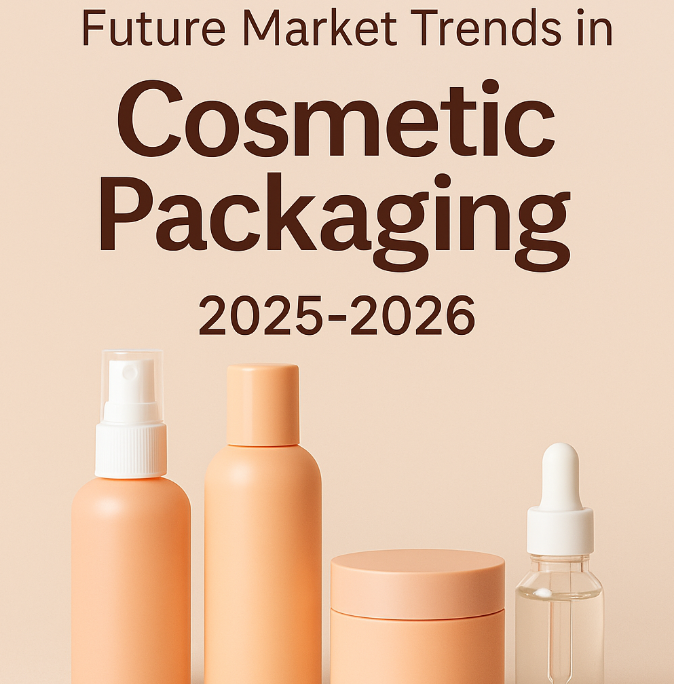The cosmetic packaging industry is undergoing a significant transformation, driven by technological advancements, sustainability initiatives, and evolving consumer preferences. As we look towards 2025 and 2026, several key trends are poised to shape the future of cosmetic packaging. This report delves into these trends, providing a comprehensive analysis based on the latest data and insights from trusted sources.

1. Sustainability in Packaging
Sustainability continues to be a dominant theme in cosmetic packaging. By 2025, sustainability has evolved beyond the use of basic recyclable materials. Beauty brands are increasingly adopting carbon-neutral and even carbon-negative packaging solutions to appeal to eco-conscious consumers. Innovations such as bioplastics, edible packaging, and zero-waste designs are becoming more widespread as brands strive to minimize their environmental impact and meet stricter regulatory requirements (Big Sky Packaging).
The growing demand for eco-friendly packaging solutions is also reflected in the adoption of materials such as biodegradable plastics, recycled content, and plant-based alternatives. This shift not only appeals to environmentally conscious consumers but also aligns with the increasing demand for sustainable beauty practices (Pinmao Cosmetic Packaging Manufacturer).
2. Technological Integration and Smart Packaging
The integration of technology into packaging is revolutionizing consumer interaction with beauty products. Smart packaging solutions, featuring QR codes, augmented reality (AR), and near-field communication (NFC) tags, are transforming the beauty industry by offering immersive experiences beyond the product itself. Consumers can scan QR codes to access tutorials, product information, or even virtual try-on features directly from their smartphones. This interactive element not only helps educate consumers but also builds brand loyalty by creating memorable, tech-enhanced experiences (Rixin Cosmetics).
Moreover, the integration of smart packaging technologies in cosmetics is driving market growth for packaging with anti-counterfeit features, enhancing product safety and authenticity (GlobeNewswire).
3. Refillable and Reusable Packaging
The trend of refillable and reusable packaging is gaining momentum, particularly in the spirits and beauty sectors. This trend is driven by the growing momentum for reusable packaging, which is well-suited for these product categories. Notable initiatives from companies like ecoSPIRITS and Estée Lauder highlight the potential for reusable packaging to reduce waste and enhance sustainability (Sustainable Packaging Coalition).
4. Innovative Dispensing Technologies
Innovative dispensing packaging is taking center stage in the cosmetic industry. New dispensing technologies, such as airless pumps, spray pumps, and dropper bottles, offer improved functionality and product preservation. These technologies are designed to minimize air exposure and preserve formulation integrity, thereby extending product shelf life and enhancing consumer satisfaction (GlobeNewswire).
5. Market Growth and Projections
The global cosmetic packaging market is experiencing robust growth. In 2023, the market was valued at approximately USD 38.5 billion and is projected to reach USD 60.4 billion by 2033, reflecting a compound annual growth rate (CAGR) of 4.6% during this period (YBJ Cosmetic Packaging Manufacturer).
The growth in the cosmetic packaging market is driven by various factors, including increasing consumer demand for premium and personalized beauty products, the growing influence of social media, and an emphasis on sustainability. The surge in consumer spending on beauty and personal care products, driven by greater disposable incomes and a growing interest in self-care, has directly boosted demand for innovative and aesthetically pleasing cosmetic packaging (GlobeNewswire).
6. Regional Insights
The Asia-Pacific region holds the largest market share in the cosmetic packaging market, driven by the increasing demand for cosmetic products and the need for innovative, attractive, and eco-friendly packaging solutions. North America is estimated to grow at the highest CAGR over the forecast period (2025-2030), reflecting the region’s focus on sustainable packaging and premium cosmetic offerings (Mordor Intelligence).
Conclusion
The cosmetic packaging industry is poised for significant transformation in 2025 and 2026, driven by sustainability, technological advancements, and evolving consumer preferences. Brands that fail to adapt to these trends risk losing relevance in a competitive market. Investing in next-generation cosmetic packaging is crucial for brands aiming to enhance brand perception, optimize costs, and comply with strict environmental regulations. As the market continues to expand, understanding these trends is essential for brands aiming to stay competitive and meet consumer expectations.

As the industry advances, partnering with experienced and forward-thinking cosmetic packaging manufacturers becomes essential. Pin Mao, a renowned cosmetic packaging manufacturer in Taiwan, stands out for its commitment to innovation, quality, and sustainability. With over 35 years of expertise, Pin Mao specializes in a wide range of packaging solutions including cosmetic plastic bottles and plastic cosmetic jars, catering to both emerging brands and established gobal names. Their emphasis on customizable, eco-friendly designs and cutting-edge production techniques makes them a reliable partner for brands seeking to stay ahead in the competitive beauty market.
